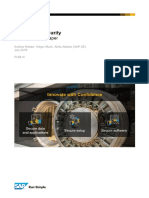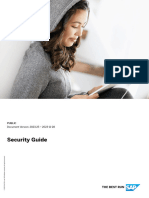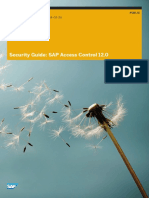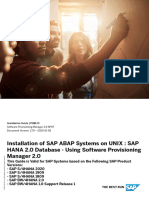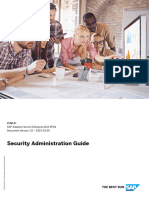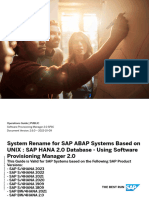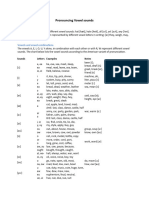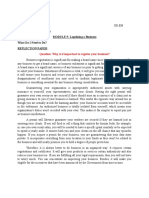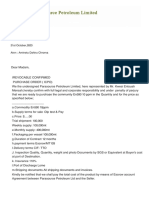SAP HANA Security Checklists and Recommendations 2023
Uploaded by
muhammad.i.sumantriSAP HANA Security Checklists and Recommendations 2023
Uploaded by
muhammad.i.sumantriPUBLIC
SAP HANA Platform 2.0 SPS 07
Document Version: 1.0 – 2023-04-04
SAP HANA Security Checklists and
Recommendations
© 2023 SAP SE or an SAP affiliate company. All rights reserved.
THE BEST RUN
Content
1 SAP HANA Security Checklists and Recommendations. . . . . . . . . . . . . . . . . . . . . . . . . . . . . . . 3
1.1 General Recommendations. . . . . . . . . . . . . . . . . . . . . . . . . . . . . . . . . . . . . . . . . . . . . . . . . . . . . . 3
1.2 Checklist for Secure Handover. . . . . . . . . . . . . . . . . . . . . . . . . . . . . . . . . . . . . . . . . . . . . . . . . . . . 4
2 SAP HANA Database Checklists and Recommendations. . . . . . . . . . . . . . . . . . . . . . . . . . . . . . .6
2.1 Recommendations for Database Users, Roles, and Privileges. . . . . . . . . . . . . . . . . . . . . . . . . . . . . . 6
2.2 Recommendations for Network Configuration. . . . . . . . . . . . . . . . . . . . . . . . . . . . . . . . . . . . . . . . 14
2.3 Recommendations for Data Encryption. . . . . . . . . . . . . . . . . . . . . . . . . . . . . . . . . . . . . . . . . . . . . 18
2.4 Recommendations for File System and Operating System. . . . . . . . . . . . . . . . . . . . . . . . . . . . . . . 20
2.5 Recommendations for Auditing Configuration. . . . . . . . . . . . . . . . . . . . . . . . . . . . . . . . . . . . . . . . 23
2.6 Recommendations for Trace and Dump Files. . . . . . . . . . . . . . . . . . . . . . . . . . . . . . . . . . . . . . . . . 25
2.7 Recommendations for Tenant Database Management. . . . . . . . . . . . . . . . . . . . . . . . . . . . . . . . . . 27
3 SAP HANA XS, Advanced Model. . . . . . . . . . . . . . . . . . . . . . . . . . . . . . . . . . . . . . . . . . . . . . . . 29
3.1 Recommendations for XS Advanced Administration User. . . . . . . . . . . . . . . . . . . . . . . . . . . . . . . . 29
3.2 Recommendations for Organizations and Spaces. . . . . . . . . . . . . . . . . . . . . . . . . . . . . . . . . . . . . . 31
3.3 Recommendations for Network Configuration. . . . . . . . . . . . . . . . . . . . . . . . . . . . . . . . . . . . . . . . 32
SAP HANA Security Checklists and Recommendations
2 PUBLIC Content
1 SAP HANA Security Checklists and
Recommendations
SAP HANA has many configuration settings that allow you to customize your system. Some of these settings
are important for the security of your system, and misconfiguration could leave your system vulnerable.
The checklists offer recommendations and information about optimizing your security configuration to help
you run your SAP HANA securely. However, please note the following:
• The checklists and recommendations offered here are not exhaustive.
In addition, depending on your specific implementation scenario and technical environment, some of the
recommendations may not apply or be different.
• Do not use the checks as instructions on how to configure individual settings.
If a particular check result indicates an insecure setting, refer to the indicated documentation and follow
the instructions there to change the configuration setting.
• This document does not replace the SAP HANA Security Guide, the central document for all information
relating to the secure operation and configuration of SAP HANA.
General Recommendations [page 3]
General recommendations for keeping SAP HANA secure.
Checklist for Secure Handover [page 4]
If you received your SAP HANA system pre-installed from a hardware or hosting partner, there are
several things we strongly recommend you do immediately after handover.
Related Information
SAP HANA Security Guide
1.1 General Recommendations
General recommendations for keeping SAP HANA secure.
• Create a security concept for the SAP HANA scenario that you want to implement as early as possible in
your implementation project.
• Install SAP HANA revisions that are marked as security-relevant as soon as possible. Do this by checking
SAP HANA security notes either directly, or using services provided by SAP Support.
For more information, see SAP HANA Security Patches in the SAP HANA Security Guide.
SAP HANA Security Checklists and Recommendations
SAP HANA Security Checklists and Recommendations PUBLIC 3
Related Information
SAP HANA Security Patches
1.2 Checklist for Secure Handover
If you received your SAP HANA system pre-installed from a hardware or hosting partner, there are several
things we strongly recommend you do immediately after handover.
• Change the password of all operating system users, in particular the following:
• <sid>adm
• <sid>crypt (if the local secure store has been installed)
• root
• sapadm
For more information, see your operating system documentation.
• In all databases, review all database users created by the installing party, and delete or deactivate those
that are not needed in your scenario.
Remember
If you received a system with tenant databases, make sure to do this in all tenant databases and in the
system database.
For more information about database users that are created in the SAP HANA database by default, see the
SAP HANA Security Guide.
• In all databases, change the password of all predefined database users, in particular the password of the
database user SYSTEM. In addition, deactivate the SYSTEM user. For more information, see the SAP HANA
Security Guide.
Remember
If you received a system with tenant databases, make sure to do this in all tenant databases and in the
system database.
Note
Predefined internal technical users (SYS, _SYS_* users) are permanently deactivated and cannot be
used to log on. It is not possible to change the password of these users.
• Change the following encryption master keys:
• Instance secure store in the file system (SSFS)
• System public key infrastructure (PKI) SSFS
For more information about how to change the encryption master keys, see SAP Note 2183624 (Potential
information leakage using default SSFS master key in HANA) and the SAP HANA Administration Guide.
• Re-create the system public key infrastructure (PKI) used to protect internal communication in
order to create new certificates and private keys. You can trigger this by deleting the system
SAP HANA Security Checklists and Recommendations
4 PUBLIC SAP HANA Security Checklists and Recommendations
PKI SSFS. Alternatively, you can use SAPControl to reset the system PKI with the methods
UpdateSystemPKI[<force>] and UpdateInstancePSE[<force>].
Note
In a system replication landscape, you must copy the system PKI SSFS data file and key file from
the primary system to the same location on the secondary system(s). For more information, see the
section on secure internal communication in the SAP HANA Security Guide.
Related Information
Deactivate the SYSTEM User
Change a Database User
Change the SSFS Master Keys
SAP Control WebService
Secure Internal Communication Between Sites in System Replication Scenarios
SAP Note 2183624
SAP HANA Security Checklists and Recommendations
SAP HANA Security Checklists and Recommendations PUBLIC 5
2 SAP HANA Database Checklists and
Recommendations
Checklists and recommendations to help you operate and configure the SAP HANA database securely
Tip
SAP Note 1969700 contains collections of useful SQL statements for monitoring and analyzing the SAP
HANA database. The statements contained in the file HANA_Security_MiniChecks.txt perform all of
the SQL-based checks listed in this documentation.
2.1 Recommendations for Database Users, Roles, and
Privileges
Recommendations for securing access to SAP HANA.
SYSTEM User
Default The database user SYSTEM is the most powerful database user with irrevocable system
privileges. The SYSTEM user is active after database creation.
Recommendation Use SYSTEM to create database users with the minimum privilege set required for their
duties (for example, user administration, system administration). Then deactivate SYSTEM.
You may however temporarily reactivate the SYSTEM user for emergency or bootstrapping
tasks. See Deactivate the SYSTEM User in the SAP HANA Security Guide.
Note
The SYSTEM user is not required to update the SAP HANA database system; a lesser-
privileged user can be created for this purpose. However, to upgrade SAP support
package stacks, SAP enhancement packages and SAP systems using the Software
Update Manager (SUM) and to install, migrate, and provision SAP systems using the
Software Provisioning Manager (SWPM), the SYSTEM user is required and needs to
be temporarily reactivated for the duration of the upgrade, installation, migration or
provisioning.
How to Verify In the system view USERS, check the values in columns USER_DEACTIVATED,
DEACTIVATION_TIME, and LAST_SUCCESSFUL_CONNECT for the user SYSTEM.
Related Alert No
SAP HANA Security Checklists and Recommendations
6 PUBLIC SAP HANA Database Checklists and Recommendations
More Information See the sections on predefined users and deactivating the SYSTEM user in the SAP HANA
Security Guide.
Password Lifetime of Database Users
Default With the exception of internal technical users (_SYS_* users), the default password policy
limits the lifetime of user passwords to 182 days (6 months).
Recommendation Do not disable the password lifetime check for database users that correspond to real
people.
In 3-tier scenarios with an application server, only technical user accounts for the database
connection of the application server should have a password with an unlimited lifetime (for
example, SAP<sid> or DBACOCKPIT).
Note
Such technical users should have a clearly identified purpose and the minimum authori
zation required in SAP HANA.
How to Verify In the USERS system view, check the value in the column
IS_PASSWORD_LIFETIME_CHECK_ENABLED. If it is FALSE, the password lifetime check is
disabled.
The time of the last password change is indicated in the column
LAST_PASSWORD_CHANGE_TIME.
Related Alert No
More Information See the section on the password policy in the SAP HANA Security Guide.
System Privileges
Default System privileges authorize database-wide administration commands. The users SYSTEM
and _SYS_REPO have all these privileges by default.
SAP HANA Security Checklists and Recommendations
SAP HANA Database Checklists and Recommendations PUBLIC 7
Recommendation System privileges should only ever be granted to users that actually need them.
In addition, several system privileges grant powerful permissions, for example, the ability to
delete data and to view data unfiltered and should be granted with extra care as follows:
Only administrative or support users should have the following system privileges in a pro
duction database:
• CATALOG READ
• TRACE ADMIN
In a database of any usage type, the following system privileges should be granted only to
administrative users who actually need them:
• ADAPTER ADMIN
• AGENT ADMIN
• AUDIT ADMIN
• AUDIT OPERATOR
• BACKUP ADMIN
• BACKUP OPERATOR
• CERTIFICATE ADMIN
• CREATE REMOTE SOURCE
• CREDENTIAL ADMIN
• ENCRYPTION ROOT KEY ADMIN
• EXTENDED STORAGE ADMIN
• INIFILE ADMIN
• LDAP ADMIN
• LICENSE ADMIN
• LOG ADMIN
• MONITOR ADMIN
• OPTIMIZER ADMIN
• RESOURCE ADMIN
• SAVEPOINT ADMIN
• SERVICE ADMIN
• SESSION ADMIN
• SSL ADMIN
• TABLE ADMIN
• TRUST ADMIN
• VERSION ADMIN
• WORKLOAD ADMIN
• WORKLOAD * ADMIN
How to Verify To check which user has a particular system privilege, query the
EFFECTIVE_PRIVILEGE_GRANTEES system view, for example:
SELECT * FROM EFFECTIVE_PRIVILEGE_GRANTEES WHERE OBJECT_TYPE
= 'SYSTEMPRIVILEGE' AND PRIVILEGE = 'SSL ADMIN' AND GRANTEE
NOT IN ('SYSTEM','_SYS_REPO');
Related Alert No
More Information See the section on system privileges in the SAP HANA Security Guide and the section on
system views for verifying user authorization in the SAP HANA Administration Guide.
SAP HANA Security Checklists and Recommendations
8 PUBLIC SAP HANA Database Checklists and Recommendations
System Privileges: Critical Combinations
Default The users SYSTEM and _SYS_REPO have all system privileges by default.
Recommendation Critical combinations of system privileges should not be granted together, for example:
• USER ADMIN and ROLE ADMIN
• CREATE SCENARIO and SCENARIO ADMIN
• AUDIT ADMIN and AUDIT OPERATOR
• CREATE STRUCTURED PRIVILEGE and STRUCTUREDPRIVILEGE ADMIN
How to Verify To check a user's privileges, query the EFFECTIVE_PRIVILEGES system view, for example:
SELECT * FROM "PUBLIC"."EFFECTIVE_PRIVILEGES" WHERE USER_NAME
= '<USER_NAME>';
Related Alert No
More Information See the section on system privileges in the SAP HANA Security Guide and the section on
system views for verifying user authorization in the SAP HANA Administration Guide.
System Privilege: DATA ADMIN
Default The system privilege DATA ADMIN is a powerful privilege. It authorizes a user to execute
all data definition language (DDL) commands in the SAP HANA database. Only the users
SYSTEM and _SYS_REPO have this privilege by default.
Recommendation No user or role in a production database should have this privilege.
How to Verify You can verify whether a user or role has the DATA ADMIN privilege by executing the
statement:
SELECT * FROM EFFECTIVE_PRIVILEGE_GRANTEES WHERE OBJECT_TYPE
= 'SYSTEMPRIVILEGE' AND PRIVILEGE = 'DATA ADMIN' AND GRANTEE
NOT IN ('SYSTEM','_SYS_REPO');
Related Alert No
More Information See the section on system privileges in the SAP HANA Security Guide and the section on
system views for verifying user authorization in the SAP HANA Administration Guide. See
also SAP Note 2950209.
System Privilege: DEVELOPMENT
Default The system privilege DEVELOPMENT authorizes some internal ALTER SYSTEM commands.
By default, only the users SYSTEM and _SYS_REPO have this privilege.
Recommendation No user or role in a production database should have this privilege.
SAP HANA Security Checklists and Recommendations
SAP HANA Database Checklists and Recommendations PUBLIC 9
How to Verify You can verify whether a user or role has the DEVELOPMENT privilege by executing the
statement:
SELECT * FROM EFFECTIVE_PRIVILEGE_GRANTEES WHERE OBJECT_TYPE
= 'SYSTEMPRIVILEGE' AND PRIVILEGE = 'DEVELOPMENT' AND GRANTEE
NOT IN ('SYSTEM','_SYS_REPO');
Related Alert No
More Information If requested by SAP HANA support, this privilege can be granted using SQL. It is not
included in the privilege handling overview in the SAP HANA Security Guide.
See the section System Views for Verifying Users' Authorization in the SAP HANA Adminis
tration Guide.
Analytic Privilege: _SYS_BI_CP_ALL
Default The predefined analytic privilege _SYS_BI_CP_ALL potentially allows a user to access all
the data in activated views that are protected by XML-based analytic privileges, regardless
of any other XML-based analytic privileges that apply.
Only the predefined roles CONTENT ADMIN and MODELING have the analytic privilege
_SYS_BI_CP_ALL by default. By default, only the user SYSTEM has these roles.
Recommendation Do not grant this privilege to any user or role in a production database.
How to Verify You can verify whether a user or role has the _SYS_BI_CP_ALL privilege by executing the
statement:
SELECT * FROM EFFECTIVE_PRIVILEGE_GRANTEES WHERE OBJECT_TYPE
= 'ANALYTICALPRIVILEGE' AND OBJECT_NAME = '_SYS_BI_CP_ALL'
AND PRIVILEGE = 'EXECUTE' AND GRANTEE NOT IN
('SYSTEM','MODELING', 'CONTENT_ADMIN');
Related Alert No
More Information See the sections on privileges and predefined database roles in the SAP HANA Security
Guide and the section on system views for verifying user authorization in the SAP HANA
Administration Guide.
Debug Privileges
Default No user has debug privileges
Recommendation The privileges DEBUG and ATTACH DEBUGGER should not be assigned to any user for any
object in production systems.
SAP HANA Security Checklists and Recommendations
10 PUBLIC SAP HANA Database Checklists and Recommendations
How to Verify You can verify whether a user or role has debug privileges by executing the statements:
SELECT * FROM GRANTED_PRIVILEGES WHERE PRIVILEGE='DEBUG' OR
PRIVILEGE='ATTACH DEBUGGER';
Related Alert No
More Information See the section on privileges in the SAP HANA Security Guide and the section on system
views for verifying user authorization in the SAP HANA Administration Guide.
Predefined Catalog Role CONTENT_ADMIN
Default The role CONTENT_ADMIN contains all privileges required for working with information mod
els in the repository of the SAP HANA database.
The user SYSTEM has the role CONTENT_ADMIN by default.
Recommendation Only the database user used to perform system updates should have the role
CONTENT_ADMIN. Otherwise do not grant this role to users, particularly in production da
tabases. It should be used as a role template only.
How to Verify You can verify whether a user or role has the CONTENT_ADMIN role by executing the state
ment:
SELECT * FROM GRANTED_ROLES WHERE ROLE_NAME = 'CONTENT_ADMIN'
AND GRANTEE NOT IN ('SYSTEM');
Related Alert No
More Information See the section on predefined database roles in the SAP HANA Security Guide and the
section on system views for verifying user authorization in the SAP HANA Administration
Guide.
Predefined Catalog Role MODELING
Default The role MODELING contains the predefined analytic privilege _SYS_BI_CP_ALL, which
potentially allows a user to access all the data in activated views that are protected by
XML-based analytic privileges, regardless of any other XML-based analytic privileges that
apply.
The user SYSTEM has the role MODELING by default.
Recommendation Do not grant this role to users, particularly in production databases. It should be used as a
role template only.
How to Verify You can verify whether a user or role has the MODELING role by executing the statement:
SELECT * FROM GRANTED_ROLES WHERE ROLE_NAME ='MODELING' AND
GRANTEE NOT IN ('SYSTEM');
Related Alert No
SAP HANA Security Checklists and Recommendations
SAP HANA Database Checklists and Recommendations PUBLIC 11
More Information See the section on predefined database roles in the SAP HANA Security Guide and the
section on system views for verifying user authorization in the SAP HANA Administration
Guide.
Predefined Catalog Role SAP_INTERNAL_HANA_SUPPORT
Default The role SAP_INTERNAL_HANA_SUPPORT contains system privileges and object privileges
that allow access to certain low-level internal system views needed by SAP HANA develop
ment support in support situations.
No user has the role SAP_INTERNAL_HANA_SUPPORT by default.
Recommendation This role should only be granted to SAP HANA development support users for their support
activities.
How to Verify You can verify whether a user or role has the SAP_INTERNAL_HANA_SUPPORT role by exe
cuting the statement:
SELECT * FROM EFFECTIVE_ROLE_GRANTEES WHERE ROLE_NAME =
'SAP_INTERNAL_HANA_SUPPORT';
Related Alert ID 63 (Granting of SAP_INTERNAL_HANA_SUPPORT role)
More Information See the section on predefined database roles in the SAP HANA Security Guide and the
section on system views for verifying user authorization in the SAP HANA Administration
Guide.
Predefined Repository Roles
Default SAP HANA is delivered with a set of preinstalled software components implemented as SAP
HANA Web applications, libraries, and configuration data. The privileges required to use
these components are contained within repository roles delivered with the component itself.
The standard user _SYS_REPO automatically has all of these roles. Some may also be
granted automatically to the standard user SYSTEM to enable tools such as the SAP HANA
cockpit to be used immediately after installation.
Recommendation As repository roles can change when a new version of the package is deployed, either do not
use them directly but instead as a template for creating your own roles, or have a regular
review process in place to verify that they still contain only privileges that are in line with
your organization's security policy.
Furthermore, if repository package privileges are granted by a role, we recommend that
these privileges be restricted to your organization’s packages rather than the complete
repository. Therefore, for each package privilege (REPO.*) that occurs in a role template
and is granted on .REPO_PACKAGE_ROOT, check whether the privilege can and should be
granted to a single package or a small number of specific packages rather than the full
repository.
SAP HANA Security Checklists and Recommendations
12 PUBLIC SAP HANA Database Checklists and Recommendations
How to Verify To verify whether a user or role has a particular role, execute the following statement, for
example:
SELECT * FROM EFFECTIVE_ROLE_GRANTEES WHERE ROLE_NAME
='sap.hana.xs.admin.roles::HTTPDestAdministrator';
Related Alert No
More Information For a list of all roles delivered with each component, see SAP HANA Security Reference
Information Components Delivered as SAP HANA Content in the SAP HANA Security
Guide.
User Parameter CLIENT
Default The CLIENT user parameter can be used to authorize named users in SAP HANA. Only
a user with the USER ADMIN system privilege can change the value of the CLIENT parame
ter already assigned to other users. However, at runtime, any user can assign an arbitrary
value to the CLIENT parameter either by setting the corresponding session variable or
passing the parameter via placeholder in a query. While this is the desired behavior for tech
nical users that work with multiple clients such as SAP Business Warehouse, S/4 HANA, or
SAP Business Suite, it is problematic in named user scenarios if the CLIENT parameter is
used to authorize access to data and not only to perform data filtering.
Recommendation Prevent named users from changing the CLIENT user parameter themselves but allow
technical users to do so in their sessions and/or queries.
How to Verify
To verify that users are generally not permitted to change the CLIENT user parameter,
ensure that the parameter [authorization] secure_client_parameter in the
global.ini file is set to true:
SELECT * FROM "M_INIFILE_CONTENTS" WHERE
KEY='SECURE_CLIENT_PARAMETER';
To verify that only permitted roles or users can change the CLIENT user parameter, execute
the following statement:
SELECT * FROM EFFECTIVE_PRIVILEGE_GRANTEES WHERE OBJECT_TYPE
= 'SYSTEMPRIVILEGE' AND PRIVILEGE = 'CLIENT PARAMETER ADMIN';
Related Alert No
More Information See SAP Note 2582162 (How to Restrict Use of the CLIENT Parameter) and the section on
authorization in the SAP HANA Administration Guide.
Related Information
Predefined Users
Deactivate the SYSTEM User
SAP HANA Security Checklists and Recommendations
SAP HANA Database Checklists and Recommendations PUBLIC 13
Password Policy
System Privileges
System Views for Verifying Users' Authorization
Predefined Database (Catalog) Roles
Predefined Repository Roles
Components Delivered as SAP HANA Content
Restrict Use of the CLIENT User Parameter
SAP Note 2582162
System Views for Verifying Users' Authorization
SAP Note 2950209
2.2 Recommendations for Network Configuration
Recommendations for integrating SAP HANA securely into your network environment.
General Recommendations
For general recommendations, please read the section on network security in the SAP HANA Security Guide.
Open Ports
Default During installation, ports such as SQL 3<instance_no>15 and HTTP 80<instance_no>
are opened by default.
Recommendation Only ports that are needed for running your SAP HANA scenario should be open. For a list of
required ports, see the SAP HANA Administration Guide.
How to Verify Verify opened ports at operating system level using Linux commands such as netcat or
netstat.
Related Alert No
More Information See the section on communication channel security in the SAP HANA Security Guide and
the section on ports and connections in the SAP HANA Administration Guide.
SAP HANA Security Checklists and Recommendations
14 PUBLIC SAP HANA Database Checklists and Recommendations
Internal Host Name Resolution in Single-Host System
Default SAP HANA services use IP addresses to communicate with each other. Host names are
mapped to these IP addresses through internal host name resolution, a technique by which
the use of specific and/or fast networks can be enforced and communication restricted
to a specific network. In single-host systems, SAP HANA services listen on the loopback
interface only (IP address 127.0.0.1).
In global.ini files, the [communication] listeninterface is set to .local.
Recommendation Do not change the default setting.
How to Verify Using SAP HANA cockpit, check which ports are listening.
This information is available in the Network Security Information app in the SAP HANA
Security Overview catalog. The value of the Listening On field should be Local Network.
Alternatively, execute the following SQL statement:
SELECT * FROM "PUBLIC" . "M_INIFILE_CONTENTS" WHERE SECTION =
'communication' AND KEY = 'listeninterface';
Related Alert No
More Information See the section about ports and connections in the SAP HANA Administration Guide.
Internal Host Name Resolution in Multiple-Host System
Default In a distributed scenario with multiple hosts, the network needs to be configured so that
inter-service communication is operational throughout the entire landscape. The default
configuration depends on how you installed your system.
SAP HANA Security Checklists and Recommendations
SAP HANA Database Checklists and Recommendations PUBLIC 15
Recommendation Multiple-host systems can run with or without a separate network definition for inter-service
communication. The recommended setting depends accordingly:
• If a separate network is configured for internal communication, the parameter
[communication] listeninterface should be set to .internal. In
addition, you should add key-value pairs for the IP addresses of the network
adapters used for SAP HANA internal communication in the [communication]
internal_hostname_resolution section.
• If a separate network is not configured for internal communication, the parameter
[communication] listeninterface should be set to .global. This setting
exposes internal SAP HANA service ports, so it is strongly recommended that you
secure internal SAP HANA ports with an additional firewall.
Note
Communication properties are in the default configuration change blocklist
(multidb.ini). This means that they cannot initially be changed in tenant data
bases. They must be changed from the system database. If appropriate for your sce
nario, you can remove these properties from the change blocklist. SAP HANA deploy
ment scenarios are described in the SAP HANA Master Guide. For more information
about how to edit the change blocklist, see the SAP HANA Administration Guide.
How to Verify Check which ports are listening using the SAP HANA cockpit.
This information is available in the Network Security Information app in the SAP HANA
Security Overview catalog. The value of the Listening On field should be Global Network or
Internal Network.
Alternatively, execute the following SQL statements:
SELECT * FROM "PUBLIC" . "M_INIFILE_CONTENTS" WHERE SECTION =
'communication' AND KEY = 'listeninterface';
SELECT * FROM "PUBLIC" . "M_INIFILE_CONTENTS" WHERE SECTION =
'internal_hostname_resolution';
Related Alert 86 (Internal communication is configured too openly)
More Information See the section on internal hostname resolution in the SAP HANA Administration Guide.
Host Name Resolution in System Replication
Default The parameter [system_replication_communication] listeninterface
parameter is set to .global.
SAP HANA Security Checklists and Recommendations
16 PUBLIC SAP HANA Database Checklists and Recommendations
Recommendation The recommended setting depends on whether or not a separate network is defined for
internal communication:
• If a separate internal network channel is configured for system replication, the
parameter [system_replication_communication] listeninterface
parameter should be .internal. You also need to add key-value pairs for
the IP addresses of the network adapters for the system replication in the
[system_replication_hostname_resolution] section.
• If a separate network is not configured for system replication, the parameter
[system_replication_communication] listeninterface should be
set to .global. However, in this case, it is important to secure communica
tion using TSL/SSL and/or to protect the SAP HANA landscape with a fire
wall. In the [system_replication_hostname_resolution] section, add
entries for all hosts of neighboring sites (at a minimum) or all hosts of own
site as well as for all hosts of neighboring sites. In addition, set the parame
ter [system_replication_communication] allowed_sender to restrict
possible communication to specific hosts. The parameter value must contain a list of
the foreign hosts that are part of the SAP HANA system replication landscape.
Note
Communication properties are in the default configuration change blocklist
(multidb.ini). This means that they cannot initially be changed in tenant data
bases. They must be changed from the system database. If appropriate for your sce
nario, you can remove these properties from the change blocklist. SAP HANA deploy
ment scenarios are described in the SAP HANA Master Guide. For more information
about how to edit the change blocklist, see the SAP HANA Administration Guide.
How to Verify To check the value of the above parameters, execute the following statements:
SELECT * FROM "PUBLIC" . "M_INIFILE_CONTENTS" WHERE
SECTION = 'system_replication_communication' AND KEY =
'listeninterface';
SELECT * FROM "PUBLIC" . "M_INIFILE_CONTENTS" WHERE
SECTION = 'system_replication_communication' AND KEY =
'internal_hostname_resolution';
SELECT * FROM "PUBLIC". "M_INIFILE_CONTENTS"WHERE
SECTION = 'system_replication_communication' AND KEY =
'allowed_sender';
Related Alert No
More Information See the section on hostname resolution for system replication in the SAP HANA Administra
tion Guide.
Related Information
Communication Channels
Network Security
SAP HANA Security Checklists and Recommendations
SAP HANA Database Checklists and Recommendations PUBLIC 17
Ports and Connections
Internal Host Name Resolution
Host Name Resolution for System Replication
2.3 Recommendations for Data Encryption
Recommendations for data encryption and encryption key management
Instance SSFS Master Key
Default The instance secure store in the file system (SSFS) protects internal root keys in the file
system. A unique master key is generated for the instance SSFS in every installation.
Recommendation If you received your system pre-installed from a hardware or hosting partner, we recom
mend that you change the master key of the instance SSFS immediately after handover to
ensure that it is not known outside of your organization.
How to Verify Check the change date of the SSFS master key
by executing the statement SELECT * FROM
M_HOST_INFORMATION WHERE KEY IN ('SSFS_MASTERKEY_CHANGED',
'SSFS_MASTERKEY_SYSTEMPKI_CHANGED')
Related Alert 84 (Insecure instance SSF encryption configuration)
More Information See the section on server-side data encryption in the SAP HANA Security Guide and the
section on changing the SSFS master keys in the SAP HANA Administration Guide.
System PKI SSFS Master Key
Default The system public key infrastructure (PKI) SSFS protects the X.509 certificate infrastruc
ture that is used to secure internal TLS/SSL-based communication. A unique master key is
generated for the system PKI SSFS in every installation.
Recommendation If you received your system pre-installed from a hardware or hosting partner, we recom
mend that you change the master key of the instance SSFS immediately after handover to
ensure that it is not known outside of your organization.
How to Verify Check the change date of the system PKI SSFS mas
ter key by executing the statement SELECT * FROM
M_HOST_INFORMATION WHERE KEY IN ('SSFS_MASTERKEY_CHANGED',
'SSFS_MASTERKEY_SYSTEMPKI_CHANGED')
Related Alert 84 (Insecure instance SSF encryption configuration)
More Information See the section on server-side data encryption in the SAP HANA Security Guide and the
section on changing the SSFS master keys in the SAP HANA Administration Guide.
SAP HANA Security Checklists and Recommendations
18 PUBLIC SAP HANA Database Checklists and Recommendations
Root Encryption Keys
Default SAP HANA features the following data encryption services:
• Data volume encryption
• Redo log encryption
• Data and log backup encryption
• An internal encryption service available to applications requiring data encryption
Unique root keys are generated for all services in every database.
Recommendation If you received your system pre-installed from a hardware or hosting partner, we recom
mend that you change all root keys immediately after handover to ensure that they are not
known outside of your organization.
How to Verify Query system view ENCRYPTION_ROOT_KEYS.
Related Alert No
More Information See the sections on server-side data encryption in the SAP HANA Security Guide and the
SAP HANA Administration Guide.
Encryption Key of the SAP HANA Secure User Store (hdbuserstore)
Default The secure user store (hdbuserstore) is a tool installed with the SAP HANA client. It is
used to store SAP HANA connection information, including user passwords, securely on
clients.
Information contained in the SAP HANA secure user store is encrypted using a unique
encryption key.
Recommendation If you are using the current version of the SAP HANA client, there is no need to change the
encryption key of the secure user store. However, if you are using an older version of the
SAP HANA client, we recommend changing the encryption key after installation of the SAP
HANA client.
How to Verify You know the encryption has been changed if the file SSFS_HDB.KEY exists in the direc
tory where the SAP HANA client is installed.
Related Alert No
More Information See the section on hdbuserstore in the SAP HANA Client Interface Programming Refer
ence and SAP Note 2210637.
Data and Log Volume Encryption
Default Data and log volume encryption are not enabled
SAP HANA Security Checklists and Recommendations
SAP HANA Database Checklists and Recommendations PUBLIC 19
Recommendation We recommend that you enable data and log volume encryption immediately after installa
tion or handover from your hardware or hosting partner, and after you have changed the
root encryption keys for both services.
How to Verify Execute the following statement:
SELECT * FROM M_ENCRYPTION_OVERVIEW WHERE SCOPE='LOG' OR
SCOPE = 'PERSISTENCE'
Related Alert No
More Information See the section on data and log volume encryption in the SAP HANA Security Guide and
the section on enabling encryption of data and log volumes in the SAP HANA Administration
Guide.
Related Information
Server-Side Data Encryption Services
Change the SSFS Master Keys
Changing Encryption Root Keys
SAP HANA User Store (hdbuserstore)
Change the User Store Encryption Key
SAP Note 2210637
Data and Log Volume Encryption
Enable Encryption
2.4 Recommendations for File System and Operating
System
Recommendations for secure operating system access and data storage in the file system
General Recommendation
Stay up to date on security recommendations available for your operating system and consider them in the
context of your implementation scenario and security policy.
See also the following SAP Notes:
• SAP Note 1944799 (SUSE Linux Enterprise Server 11.x for SAP Applications)
• SAP Note 2009879 (Red Hat Enterprise Linux (RHEL) 6.x)
SAP HANA Security Checklists and Recommendations
20 PUBLIC SAP HANA Database Checklists and Recommendations
Operating System Users
Default Only operating system (OS) users that are needed for operating SAP HANA exist on the SAP
HANA system, that is:
• sapadm (required to authenticate to SAP Host Agent)
• <sid>adm (required by the SAP HANA database)
• <sid>crypt (if the local secure store has been installed)
• Dedicated OS users for every tenant database if the system is configured for high
isolation
Note
There may be additional OS users that were installed by the hardware vendor. Check
with your vendor.
Recommendation Ensure that no additional unnecessary users exist.
How to Verify Refer to your operating system documentation
Related Alert No
More Information See the section on predefned users in the SAP HANA Security Guide.
OS File System Permissions
Default The access permission of files exported to the SAP HANA server can be configured us
ing the [import_export] file_security parameter in the indexserver.ini
configuration file. The default permission set is 640 ([import_export]
file_security=medium).
Recommendation Do not change default access permission of exported files. In addition, ensure that only a
limited number of database users have the system privilege IMPORT and EXPORT.
How to Verify • You can verify the parameter setting by executing the command:
SELECT * FROM "PUBLIC" . "M_INIFILE_CONTENTS" WHERE
SECTION = 'import_export' AND KEY = 'file_security';
• You can verify which users or roles have the IMPORT or EXPORT privilege by executing
the statement:
SELECT * FROM EFFECTIVE_PRIVILEGE_GRANTEES WHERE
(OBJECT_TYPE = 'SYSTEMPRIVILEGE') AND (PRIVILEGE =
'EXPORT' OR PRIVILEGE='IMPORT');
• You can verify the permissions of directories in the file system using the SAP HANA
database lifecycle manager (HDBLCM) resident program with installation parameter
check_installation.
Related Alert No
SAP HANA Security Checklists and Recommendations
SAP HANA Database Checklists and Recommendations PUBLIC 21
More Information See the section on checking the installation of an SAP HANA system using the SAP HANA
database lifecycle manager (HDBLCM) in the SAP HANA Administration Guide, as well as
SAP Note 2252941.
OS Security Patches
Default OS security patches are not installed by default
Recommendation Install OS security patches for your operating system as soon as they become available. If a
security patch impacts SAP HANA operation, SAP will publish an SAP Note where this fact
is stated. It is up to you to decide whether to install such patches.
How to Verify Refer to your operating system documentation
Related Alert No
More Information • SAP Note 1944799 (SUSE Linux Enterprise Server 11.x for SAP Applications)
• SAP Note 2009879 (Red Hat Enterprise Linux (RHEL) 6.x)
OS sudo Configuration
Default Users have to either specify the root password or be part of a dedicated user group to be
able to run arbitrary commands as root.
Recommendation Do not change your sudo configuration to allow users such as <sid>adm to use sudo to run
arbitrary commands as root without specifying the root password.
How to Verify Check the /etc/sudoers file. The specific configuration may vary with your Linux distri
bution, but configuration options to look for are:
• Defaults targetpw
This setting requires the root password to be provided when running sudo in general.
• ALL ALL=(ALL) ALL
This should only be used if Defaults targetpw is also set.
If you use the storage connector option to mount SAP HANA volumes, during SAP HANA
installation your sudo configuration is modified to allow <sid>adm to run a dedicated set of
commands as root, such as:
<sid>
This is intentional and does not pose a security risk. However, <sid>adm
should not be able to run arbitrary commands as root without proper au
thentication. adm ALL=NOPASSWD: /sbin/multipath,/sbin/multipathd,/etc/init.d/multi
pathd,/usr/bin/sg_persist,/bin/mount [...]
Related Alert No
More Information See the sudo and sudoers documentation (man 8 sudo, man 5 sudoers)
SAP HANA Security Checklists and Recommendations
22 PUBLIC SAP HANA Database Checklists and Recommendations
Related Information
Predefined Users
Check the Installation Using the Command-Line Interface
SAP Note 2252941
SAP Note 1944799
SAP Note 2009879
2.5 Recommendations for Auditing Configuration
Recommendations for audit configuration
Auditing
Default Auditing is disabled by default.
Recommendation Verify whether auditing is required by your security concept, for example to fulfill specific
compliance and regulatory requirements.
How to Verify Check the status of auditing in the SAP HANA cockpit
This information is available on the Auditing card of the Database Overview page.
Alternatively, you can execute the following statement:
SELECT * FROM "PUBLIC" . "M_INIFILE_CONTENTS" WHERE SECTION =
'auditing configuration' AND KEY = 'global_auditing_state';
Related Alert No
More Information See the sections on auditing in the SAP HANA Security Guide and the SAP HANA Adminis
tration Guide.
Audit Trail Target: syslog
Default The default audit trail target is syslog (SYSLOGPROTOCOL) for the system database
Recommendation If you are using syslog, ensure that it is installed and configured according to your require
ments (for example, for writing the audit trail to a remote server).
How to Verify Refer to your operating system documentation
Related Alert No
SAP HANA Security Checklists and Recommendations
SAP HANA Database Checklists and Recommendations PUBLIC 23
More Information See the section on audit trails in the SAP HANA Security Guide and your operating system
documentation.
Audit Trail Target: CSV Text File
Default The audit trail target CSV text file (CSVTEXTFILE) is not configured by default
Recommendation Do not configure CSV text file (CSVTEXTFILE) as an audit trail target in a production system
as it has severe restrictions.
How to Verify Check the configured audit trail targets in the Auditing of the SAP HANA cockpit
Alternatively, execute the following statements:
• SELECT * FROM "PUBLIC" . "M_INIFILE_CONTENTS" WHERE
SECTION = 'auditing configuration' AND VALUE =
'CSVTEXTFILE';
• SELECT * FROM "PUBLIC"."AUDIT_POLICIES" WHERE
TRAIL_TYPE='CSV';
Related Alert No
More Information See the section on audit trails in the SAP HANA Security Guide.
Related Information
Auditing Activity in SAP HANA
Audit Trails
Auditing Activity in the SAP HANA Database
CREATE AUDIT POLICY Statement (Access Control)
Best Practices and Recommendations for Creating Audit Policies
SAP HANA Security Checklists and Recommendations
24 PUBLIC SAP HANA Database Checklists and Recommendations
2.6 Recommendations for Trace and Dump Files
Recommendations for handling trace and dump files
Trace Files
Default Basic tracing of activity in database components is enabled by default, with each database
service writing to its own trace file. Other traces (for example, SQL trace, expensive state
ments trace, performance trace) must be explicitly enabled.
Users with the system privilege CATALOG READ can read the contents of trace files in
the SAP HANA database explorer. At operating system level, any user in the SAPSYS
group can access the trace directory: /usr/sap/<SID>/HDB<instance>/<host>/
trace/<db_name>
Recommendation • Enable tracing to troubleshoot specific problems only and then disable.
• Exercise caution when setting or changing the trace level. A high trace level may expose
certain security-relevant data (for example, database trace level DEBUG or SQL trace
level ALL_WITH_RESULTS).
• Delete trace files that are no longer needed.
How to Verify You can check which traces are enabled and how they are configured, as well as view trace
files in the SAP HANA database explorer.
Related Alert No
More Information See the section on security risks of trace and dump files in the SAP HANA Security Guide
and the section on traces in the SAP HANA Administration Guide.
SAP HANA Security Checklists and Recommendations
SAP HANA Database Checklists and Recommendations PUBLIC 25
Dump Files
Default The system generates core dump files (for example, crash dump files) automatically. Run
time (RTE) dump files can be triggered explicitly, for example by using the SAP HANA
database management console (hdbcons) or as part of a full system information dump
(fullSystemInfoDump.py) using the SAP HANA cockpit.
RTE dump files must be generated by the <sid>adm user.
Caution
Technical expertise is required to use hdbcons. To avoid incorrect usage, use hdbcons
only with the guidance of SAP HANA development support.
To create RTE dump files in a running system as part of a full system information
dump in the SAP HANA cockpit, a user requires the EXECUTE privilege on procedure
SYS.FULL_SYSTEM_INFO_DUMP_CREATE.
Dump files are stored in the trace directory and have the same access permissions as other
trace files (see above).
Runtime dump files created as part of a full system information dump
can be retrieved by users with the EXECUTE privilege on the procedure
SYS.FULL_SYSTEM_INFO_DUMP_RETRIEVE using the SAP HANA cockpit. At operat
ing system level, any user in the SAPSYS group can access their storage loca
tion: /usr/sap/SID/SYS/global/sapcontrol/snapshots
Recommendation • Generate runtime dump files to analyze specific error situations only, typically at the
request of SAP support.
• Delete dump files that are no longer needed.
How to Verify • You can view core dump files in the SAP HANA database explorer
• You can download the file collections generated by a full system information dump in
the SAP HANA cockpit.
Related Alert No
More Information See the section on security risks of trace and dump files in the SAP HANA Security Guide
and the section on collecting diagnosis information for SAP Support in the SAP HANA
Administration Guide.
Related Information
Security Risks of Trace, Dump, and Captured Workload Files
Collecting Diagnosis Information for SAP Support
SAP HANA Security Checklists and Recommendations
26 PUBLIC SAP HANA Database Checklists and Recommendations
2.7 Recommendations for Tenant Database Management
Recommendations for securely configuring tenant databases
SAML-Based User Authentication
Default All tenant databases use the same trust store as the system database for SAML-based user
authentication
Recommendation To prevent users of one tenant database being able to log on to other databases in the sys
tem (including the system database) using SAML, create individual certificate collections
with the purpose SAML and SSL in every tenant database.
In addition, specify a non-existent trust store for every tenant database using the
[communication] sslTrustStore property in the global.ini file.
How to Verify Execute the following statements:
• In the tenant database: SELECT * FROM PSES WHERE PURPOSE ='SAML'
OR PURPOSE ='SSL';
• In the system database: SELECT
* FROM SYS_DATABASES.M_INIFILE_CONTENTS
WHERE DATABASE_NAME='<TENANT_DB_NAME>' AND
SECTION='communication' AND KEY = 'ssltruststore';
Related Alert No
More Information See the sections on SSL configuration on the SAP HANA server and certficate collections in
the SAP HANA Security Guide.
Configuration Blocklist
Default A configuration change blocklist (multidb.ini) is delivered with a default configuration.
The parameters contained in the blocklist can only be changed by a system administrator in
the system database, not by the administrators of individual tenant databases.
Recommendation Verify that the parameters included in the multidb.ini file meet your requirements and
customize if necessary.
How to Verify To see which parameters are blocklisted, execute the statement:
SELECT * FROM "PUBLIC". "M_INIFILE_CONTENTS" WHERE FILE_NAME
= 'multidb.ini';
Related Alert No
SAP HANA Security Checklists and Recommendations
SAP HANA Database Checklists and Recommendations PUBLIC 27
More Information See the section on default blocklisted system properties in tenant databases in the SAP
HANA Security Guide and the section on how to prevent changes to system properties in
tenant databases in the SAP HANA Administration Guide.
Restricted Features
Default To safeguard and/or customize your system, it is possible to disable certain database
features that provide direct access to the file system, the network, or other resources, for
example import and export operations and backup functions.
No features are disabled by default.
Recommendation Review the list of features that can be disabled and disable those that are not required in
your implementation scenario.
How to Verify To see the status of features, query the system view
M_CUSTOMIZABLE_FUNCTIONALITIES:
SELECT * FROM "PUBLIC". "M_CUSTOMIZABLE_FUNCTIONALITIES";
Related Alert No
More Information See the section on restricted features in tenant databases in the SAP HANA Security Guide
and the section on how to disable features on tenant databases in the SAP HANA Adminis
tration Guide.
Related Information
TLS/SSL Configuration on the SAP HANA Server
Certificate Collections
Default Blocklisted System Properties in Tenant Databases
Prevent Changes to System Properties in Tenant Databases
Restricted Features in Tenant Databases
Disable Features on a Tenant Database
SAP HANA Security Checklists and Recommendations
28 PUBLIC SAP HANA Database Checklists and Recommendations
3 SAP HANA XS, Advanced Model
Checklists and recommendations to help you operate and configure the SAP HANA XS Advanced Model
runtime securely
3.1 Recommendations for XS Advanced Administration
User
Recommendations for XS advanced administration user
XSA_ADMIN User
Default XSA_ADMIN is a firstlevel administrator user with irrevocable privileges. This user has
unlimited access to the Controller and therefore needs to be handled carefully.
Recommendations • Change the XSA_ADMIN password at regular intervals.
• Avoid creating other powerful users with privileges similar to XSA_ADMIN.
• Keep the number of people with XSA_ADMIN credentials as small as possible. Delegate
specific tasks like space management to lesser-privileged users instead.
Alternatively, set up lesser-privileged XS advanced users to run the server without the
administrative user. Then deactivate the XSA_ADMIN user. See the next section.
How to Verify SELECT DISTINCT USER_NAME FROM USER_PARAMETERS WHERE
PARAMETER = 'XS_RC_XS_CONTROLLER_ADMIN'
Note
This statement can only be executed by a user administrator.
Related Alert No
More Information See the section on predefined XS advanced users in the SAP HANA Security Guide.
SAP HANA Security Checklists and Recommendations
SAP HANA XS, Advanced Model PUBLIC 29
Initial Setup with XSA_ADMIN
Default The XSA_ADMIN user can use the Controller without any restrictions and is the only user
in a position to do the initial setup of the model. This includes appointing at least one Org
Manager who is able to set up spaces, and managing global resources such as buildpacks
and external brokers.
Recommendations
Set up your system so that XSA_ADMIN is not needed for normal system operation. You can
do this as follows:
1. Perform the basic settings that require the administrative access rights of XSA_ADMIN
as required:
• Install custom SSL certificates (xs trust-certificate and xs set-
certificate commands)
• Appoint at least one XS advanced user to be OrgManager of each organization
(strongly recommended)
• Register all required service brokers (optional)
• Create all required shared domains (optional)
• Create all required custom buildpacks (optional)
• Create all required runtimes (optional)
• Configure logical databases (optional)
• Set up global environment variables (xs set_running|
staging_environment_variable_groups command) (optional)
2. Grant one or more XS advanced users the following role collections:
• XS_AUTHORIZATION_ADMIN (managing roles, role-collections, and so on)
• XS_USER_ADMIN (assigning role-collections to XS advanced users)
3. Deactivate the XSA_ADMIN with the following SQL statement:
ALTER USER XSA_ADMIN DEACTIVATE USER NOW
Note
In an emergency, a user with system privilege USER ADMIN can reactivate this user
with the SQL statement:ALTER USER XSA_ADMIN ACTIVATE USER NOW
How to Verify In the system view USERS, check the values in columns USER_DEACTIVATED, DEACTIVA
TION_TIME, and LAST_SUCCESSFUL_CONNECT for the user XSA_ADMIN.
Related Alert No
More Information See the section on scopes, attributes, and role collections in the SAP HANA Security Guide.
Related Information
Predefined XS Advanced Users
Scopes, Attributes, and Role Collections
SAP HANA Security Checklists and Recommendations
30 PUBLIC SAP HANA XS, Advanced Model
3.2 Recommendations for Organizations and Spaces
Recommendations for setting up organizations and spaces
Space Isolation
Default The instances of applications in the same space run with the same operating system (OS)
user. Each space can have a different OS user.
Recommendations For space isolation, each space should use an own dedicated OS user only for this space.
How to Verify Current space user mapping can be viewed with the xs spaces command. The user
column shows the used OS user for each listed space.
Related Alert No
More Information See the section on organizations and spaces in the SAP HANA Security Guide.
Privileges of Space Operating System (OS) User
Default Spaces are mapped to operating system (OS) users that are used to stage and run applica
tions.
Recommendations • Don’t use <sid>adm or any other high privileged OS user as a space OS user.
• Restrict the privileges of the space OS user as much as possible.
How to Verify Current space user mapping can be viewed with the xs spaces command. Verify the OS
privileges of each OS users listed.
Related Alert No
More Information See the section on organizations and spaces in the SAP HANA Security Guide.
SAP Space
Default System applications are deployed to the SAP space by default.
Recommendations Use the PROD space to deploy your applications, or create new spaces for the applications
as required. To ensure isolation, do not deploy your applications to the SAP space. In addi
tion, do not assign the SpaceDeveloper role to platform users in the SAP space, unless it
is absolutely necessary.
How to Verify Log on to the SAP space and use the xs apps command to confirm that the list of applica
tions running in the target space (SAP) includes only system applications, for example, the
deployer, the product-installer, etc.
SAP HANA Security Checklists and Recommendations
SAP HANA XS, Advanced Model PUBLIC 31
Related Alert No
More Information See the section on organizations and spaces in the SAP HANA Security Guide.
Logon with xs CLI
Default XS advanced session is stored in the file system of the current OS user
Recommendations We recommend logging on to XS advanced (xs login command) only with a personal OS
user with a home directory that is not readable to other OS users.
How to Verify -
Related Alert No
Related Information
Organizations and Spaces
3.3 Recommendations for Network Configuration
Recommendations for integrating SAP HANA XS advanced securely into your network environment.
Network and Communication Security
Default The XS advanced platform router, which is realized by an SAP Web Dispatcher instance,
exposes the public end point for the whole system. The router is configured in a way that
all application and public server end points are represented by an external URL. External
requests are routed to the appropriate back-end instance according to the internal routing
table.
Recommendations Limit network access to your system in a way that only the platform router's end points are
accessible from outside the system. This can be accomplished by means of network zones
and firewalls.
How to Verify Get in touch with your network administrators.
Related Alert No
More Information See the sections on XS advanced application server components and public end points in
the SAP HANA Security Guide.
SAP HANA Security Checklists and Recommendations
32 PUBLIC SAP HANA XS, Advanced Model
Default The XS advanced platform router, which is realized by an SAP Web Dispatcher instance,
accepts cipher suites TLS 1.0, TLS 1.1 and TLS 1.2 for external requests, by default. The
weaker suite TLS 1.0 is allowed due to the fact that a lot of clients do not support higher
protocol versions.
Recommendations If the limitation for some non-compatible clients is accepted, it is recommended to disable
all TLS versions below TLS 1.2 as described in the SAP HANA Administration Guide.
Related Alert No
More Information See the following section of the SAP HANA Administration Guide: Application Run-Time
Services Maintaining the SAP HANA XS Advanced Model Run Time Configuring the XS
Advanced Platform Router Configuring the Platform Router with INI Parameters
Security Areas
Default The JDBC connection to the SAP HANA database is not encrypted by default.
Recommendations Activate JDBC TLS/SSL between application server and the SAP HANA database in all
scenarios. Configure custom SSL certificates as described in the SAP HANA Security Guide.
How to Verify Get in touch with your network administrators.
Related Alert No
More Information See the section on XS advanced certificate management in the SAP HANA Security Guide.
Certificate Management
Default By default, the XS advanced server runs with self-signed certificate for all domains.
Recommendations Configure the XS advanced server to accept a custom certificate for all your domains,
especially the shared domain (used for XS CLI communication). Custom certificates can be
upload by using the xs set-certificate command for each domain.
How to Verify Check the certificate in your Web browser when loading from a specific domain.
Related Alert No
More Information See the section on XS advanced certificate management in the SAP HANA Security Guide,
as well as SAP Note 2243019 in Related Information below.
Related Information
Application Server Components
Public Endpoints
XS Advanced Certificate Management
Configuring the XS Advanced Platform Router
SAP HANA Security Checklists and Recommendations
SAP HANA XS, Advanced Model PUBLIC 33
SAP Note 2243019
SAP HANA Security Checklists and Recommendations
34 PUBLIC SAP HANA XS, Advanced Model
Important Disclaimer for Features in SAP
HANA
For information about the capabilities available for your license and installation scenario, refer to the Feature
Scope Description for SAP HANA.
SAP HANA Security Checklists and Recommendations
Important Disclaimer for Features in SAP HANA PUBLIC 35
Important Disclaimers and Legal Information
Hyperlinks
Some links are classified by an icon and/or a mouseover text. These links provide additional information.
About the icons:
• Links with the icon : You are entering a Web site that is not hosted by SAP. By using such links, you agree (unless expressly stated otherwise in your
agreements with SAP) to this:
• The content of the linked-to site is not SAP documentation. You may not infer any product claims against SAP based on this information.
• SAP does not agree or disagree with the content on the linked-to site, nor does SAP warrant the availability and correctness. SAP shall not be liable for any
damages caused by the use of such content unless damages have been caused by SAP's gross negligence or willful misconduct.
• Links with the icon : You are leaving the documentation for that particular SAP product or service and are entering an SAP-hosted Web site. By using
such links, you agree that (unless expressly stated otherwise in your agreements with SAP) you may not infer any product claims against SAP based on this
information.
Videos Hosted on External Platforms
Some videos may point to third-party video hosting platforms. SAP cannot guarantee the future availability of videos stored on these platforms. Furthermore, any
advertisements or other content hosted on these platforms (for example, suggested videos or by navigating to other videos hosted on the same site), are not within
the control or responsibility of SAP.
Beta and Other Experimental Features
Experimental features are not part of the officially delivered scope that SAP guarantees for future releases. This means that experimental features may be changed by
SAP at any time for any reason without notice. Experimental features are not for productive use. You may not demonstrate, test, examine, evaluate or otherwise use
the experimental features in a live operating environment or with data that has not been sufficiently backed up.
The purpose of experimental features is to get feedback early on, allowing customers and partners to influence the future product accordingly. By providing your
feedback (e.g. in the SAP Community), you accept that intellectual property rights of the contributions or derivative works shall remain the exclusive property of SAP.
Example Code
Any software coding and/or code snippets are examples. They are not for productive use. The example code is only intended to better explain and visualize the syntax
and phrasing rules. SAP does not warrant the correctness and completeness of the example code. SAP shall not be liable for errors or damages caused by the use of
example code unless damages have been caused by SAP's gross negligence or willful misconduct.
Bias-Free Language
SAP supports a culture of diversity and inclusion. Whenever possible, we use unbiased language in our documentation to refer to people of all cultures, ethnicities,
genders, and abilities.
SAP HANA Security Checklists and Recommendations
36 PUBLIC Important Disclaimers and Legal Information
SAP HANA Security Checklists and Recommendations
Important Disclaimers and Legal Information PUBLIC 37
www.sap.com/contactsap
© 2023 SAP SE or an SAP affiliate company. All rights reserved.
No part of this publication may be reproduced or transmitted in any form
or for any purpose without the express permission of SAP SE or an SAP
affiliate company. The information contained herein may be changed
without prior notice.
Some software products marketed by SAP SE and its distributors
contain proprietary software components of other software vendors.
National product specifications may vary.
These materials are provided by SAP SE or an SAP affiliate company for
informational purposes only, without representation or warranty of any
kind, and SAP or its affiliated companies shall not be liable for errors or
omissions with respect to the materials. The only warranties for SAP or
SAP affiliate company products and services are those that are set forth
in the express warranty statements accompanying such products and
services, if any. Nothing herein should be construed as constituting an
additional warranty.
SAP and other SAP products and services mentioned herein as well as
their respective logos are trademarks or registered trademarks of SAP
SE (or an SAP affiliate company) in Germany and other countries. All
other product and service names mentioned are the trademarks of their
respective companies.
Please see https://www.sap.com/about/legal/trademark.html for
additional trademark information and notices.
THE BEST RUN
You might also like
- SAP HANA Security Checklists and RecommendationsNo ratings yetSAP HANA Security Checklists and Recommendations36 pages
- SAP HANA Security Checklists and Recommendations enNo ratings yetSAP HANA Security Checklists and Recommendations en36 pages
- Unit 2: Security: Week 3: Managing Individual DatabasesNo ratings yetUnit 2: Security: Week 3: Managing Individual Databases9 pages
- E - 20220426 Security Checks in SAP EarlyWatch Alert, EarlyWatch and GoingLive SessionsNo ratings yetE - 20220426 Security Checks in SAP EarlyWatch Alert, EarlyWatch and GoingLive Sessions12 pages
- Administrator Guide SAP Access Control 12.0 SP02No ratings yetAdministrator Guide SAP Access Control 12.0 SP0250 pages
- Installation of SAP ABAP Systems On UNIX SAP HANA 2.0 Database Using SWPM 2.0No ratings yetInstallation of SAP ABAP Systems On UNIX SAP HANA 2.0 Database Using SWPM 2.0206 pages
- Best Practices and Examples For Developing Roles in SAP HANA - Example ProjectNo ratings yetBest Practices and Examples For Developing Roles in SAP HANA - Example Project48 pages
- SAP HANA Security: Technical WhitepaperNo ratings yetSAP HANA Security: Technical Whitepaper23 pages
- Whats New SAP HANA Platform Release Notes enNo ratings yetWhats New SAP HANA Platform Release Notes en376 pages
- Installation and Configuration Guide For SAP Assurance and Compliance Software For SAP S4HANA - 1.5SP00No ratings yetInstallation and Configuration Guide For SAP Assurance and Compliance Software For SAP S4HANA - 1.5SP0078 pages
- Greater NY Taxi Assoc V NYCTLC #101083-13 - Art 78 - DONo ratings yetGreater NY Taxi Assoc V NYCTLC #101083-13 - Art 78 - DO13 pages
- Acceptance and Commitment Therapy For Hypersexuality A Pilot StudyNo ratings yetAcceptance and Commitment Therapy For Hypersexuality A Pilot Study20 pages
- MODULE 5: Legalizing A Business What Do I Need To Do? Reflection PaperNo ratings yetMODULE 5: Legalizing A Business What Do I Need To Do? Reflection Paper1 page
- Robert A. Gunn - Vaccination: Its Fallacies and Evils (1882)100% (2)Robert A. Gunn - Vaccination: Its Fallacies and Evils (1882)44 pages
- Allama Iqbal Open University Islamabad: Book Name (8612) Level: B.EdNo ratings yetAllama Iqbal Open University Islamabad: Book Name (8612) Level: B.Ed9 pages
- Michael - Vince Advanced Language Practice With Key Pages 179 180184 186 1No ratings yetMichael - Vince Advanced Language Practice With Key Pages 179 180184 186 15 pages
- Arts in Healthcare: State of The Field ReportNo ratings yetArts in Healthcare: State of The Field Report33 pages
- World's Iconic Women Leaders in Travel & Hospitality, 2025No ratings yetWorld's Iconic Women Leaders in Travel & Hospitality, 202544 pages








